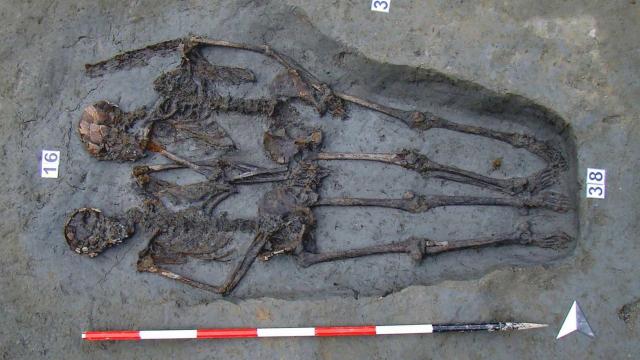A new analysis of the Lovers of Modena — a pair of 1,600-year-old skeletons found buried with their hands clasped together — reveals the pair as being male, in a discovery unique to archaeology.
Found 10 years ago in an Italian Late Antiquity cemetery, the Lovers of Modena were initially presumed to be a male and female couple. That said, a definitive determination of sex wasn’t possible owing to the poor preservation of the skeletons. Surprising new research published this week in Scientific Reports shows that both skeletons were male, upending previous conceptions of the supposed lovers.
It’s not unusual to see couples buried together, including couples placed in spooning positions or holding hands. Examples include the 6,000-year-old Lovers of Valdaro, also from Italy, a couple from Greece dating back to roughly the same era, and an elderly Russian couple dating to between 4,500 and 5,000 years ago, among other instances.
As for finding pairs of men holding hands, not so much.
According to the new paper, co-authored by archaeologist Federico Lugli from the University of Bologna, the archaeological record is essentially devoid of examples in which men are buried hand-in-hand. “Such a gesture,” the authors wrote, “was uncommon if not totally unrepresented in the art of Late Antiquity or, in general, before modern times.” The authors aren’t sure why the two men were buried in such a manner, but the “discovery of two adult males intentionally buried hand-in-hand may have profound implications for our understanding of funerary practices in Late Antique Italy.”
The Lovers of Modena were found in a Late Antiquity cemetery dating to between the fourth and sixth century CE. In addition to these two, archaeologists unearthed 11 additional skeletons, many of them exhibiting serious injuries. The ancient cemetery is located in the city of Modena in northern Italy.
As noted, the skeletons were found in a very bad state of preservation, making it difficult for scientists to initially and definitively identify the sex of the individuals. The bone tissue, for example, was so badly damaged that any genetic information derived from the skeletons was deemed unreliable. When news of the 2009 discovery reached the press, however “mass media had immediately assumed they were a male-female couple, even if bad preservation of the bones did not allow an effective sex classification,” wrote the authors in the study.
To finally determine the sex of the couple, Lugli and his colleagues analysed proteins recovered from the skeletons’ tooth enamel. Specifically, the researchers tested a protein called AMELY, or amelogenin isoform Y, which is increasingly being used by scientists to determine the sex of ambiguous remains. Through this technique, researchers can spot peptides in the enamel protein specific to either males or females, which in this case pointed to the former. Previous research has shown this technique to be upwards of 99.84 per cent accurate.
In addition to determining sex, the researchers also found that the men were around 20 years old when they died.
So who were these men? And why were they buried with their hands together?
Given the limited evidence, the authors weren’t able to rule out an obvious possibility: the men were gay. That said, they deemed this scenario unlikely given the social norms and laws in place at the time, as the authors explained in the study:
Although we cannot exclude that these two individuals were actually in love, it is unlikely that people who buried them decided to show such bond by positioning their bodies hand in hand. Particularly, Late Antique social attitudes and Christian religious restrictions lead to the rejection of any hypothesis of deliberate manifestation of homosexual relationship. In fact, since 390 [CE], male [homosexuality] was frowned upon by law and, during the reign of Justinian (527–565), sex between males was fully considered a crime.
Instead, the researchers hypothesised that the young men were close relatives, either brothers or cousins. Alternately, the men were soldiers who died together in mortal combat, and then buried in what is presumed to be a war cemetery. Indeed, some of the skeletons buried at this site exhibited signs of trauma, which could be connected to warfare, according to the new research.
The reason for the hand-in-hand burial isn’t clear, but what is clear is the uncommon nature of this discovery and what it tells us about Late Roman burial practices. As such, the find displays “a unique representation of commitment between two men” during this time period, concluded the authors.
